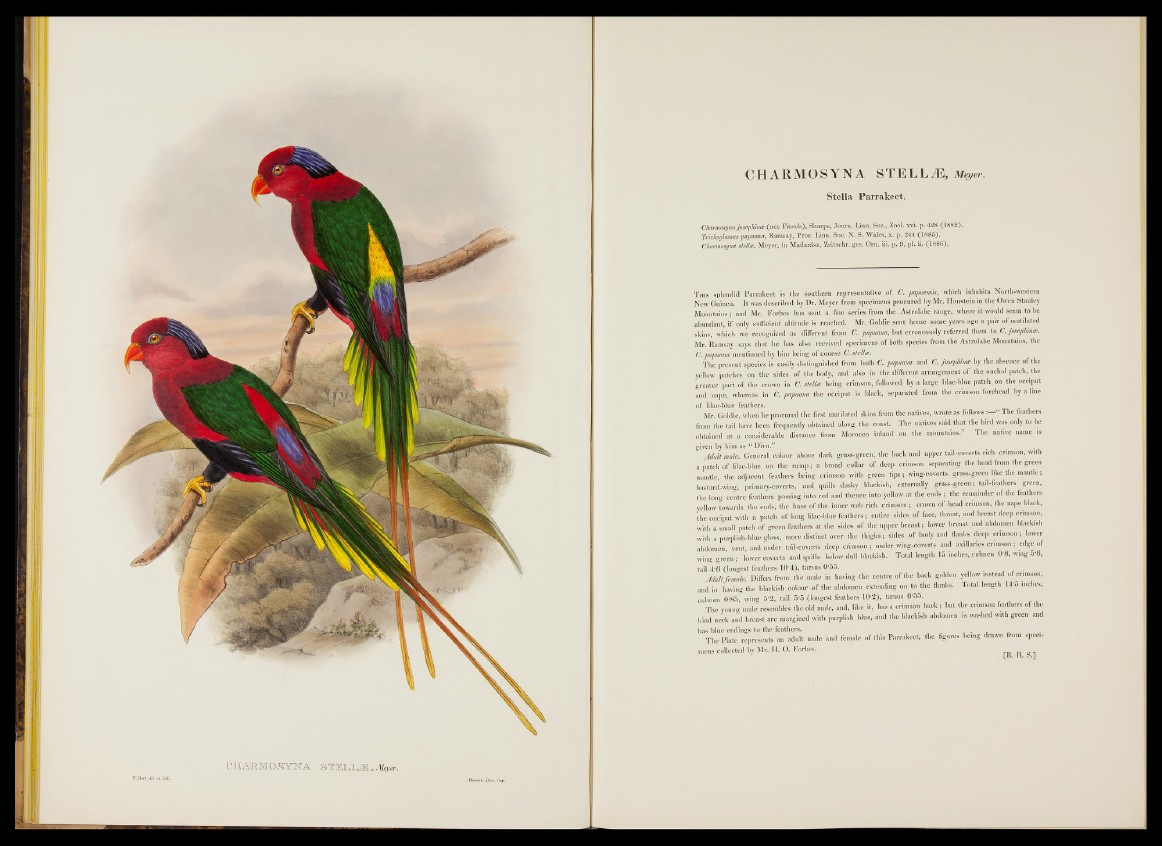
CHARMOSYNA STELLA, Meyer.
Stella Parrakeet.
Charimsyna jose/ihiiue (nec Finsch), Sharpe, Journ. Linn. Soc., Zool. xvi. p. 4*28 (1882).
Trichogbssus papuana, Ramsay,. Proc. Linn. Soc. N. S. Wales, x. p. 244 (1885).
Charmosgna stella, Meyer, in MadarSsz, Zeitschr. ges. Om. iii. p. 3, pi. i i . (1886).
T his splendid Parralteet is the southern representative o f C. papuemis, which inhabits North-western
New G uinea. I t was described by D r. Meyer from specimens procured by Mr. Hunstein in the Owen Stanley
Mountains; and Mr. Forbes has sent a line series from the Astrolabe range, where it would seem to be
abundant, if only sufficient, altitude is reached. Mr. Goldie sent home some years ago a pair o f mutilated
skins, which we recognised as different from C. papuam, hut erroneously referred them to C.josepMnte.
Mr. Ramsay says that he has also received specimens of both species from the Astrolabe Mountains, the
C. papuana mentioned by him being of course C. Stella.
T h e present species is easily distinguished from both C. papuana and C. josephince by the absence o f the
yellow patches on the sides o f the body, and also in the different arrangement o f the nuchal patch, the
g reater p a rt o f the crown in C. Stella being crimson, followed by a large lilac-blue patch on the occiput
and nape, whereas in C. papuana the occiput, is black, separated from the crimson forehead h y a lin e
o f lilac-blue feathers.
Mr. Goldie, when he procured the first mutilated skins from the natives, wrote as follows : ||§ T h e feathers
from the tail have been frequently obtained along the coasts): The natives said th at the bird was only to be
obtained at a considerable distance from Morocco inland on the mountains." The native name is
given by him as “ Divu.” . . .
Adult male. General colour above dark grass-green, the back and upper tail-coverts rich crimson, with
a patch o f lilac-ldue on the rump ; a broad collar o f deep crimson separating the head from the green
mantle, the adjacent feathers being crimson with green tip s ; wing-coverts grass-green like the m antle;
bastard-wing, primary-coverts, and quills dusky blackish, externally grass-green; tail-feathers green,
t he long centre feathers passing into red and thence into yellow at the ends ; the remainder of the feathers
yellow towards the ends, the base o f the Inner web rich c rim so n ; crown of head crimson, the nape black,
tbe iocHput with a patch o f long lila rf ftie fea th e rs, entire sides o f face, throat, and breast deep crimson,
with a small patch of green feathers at the sides of the upper b r e a s t: lower breast and abdomen blackish
with a purplish-blue gloss, more distinct over the th ig h s; s i d e s » body and flanks deep crimson; lower
abdomen vent, and under tail-coverts deep crimson ; under wing-coverts and axillaries crimson ; edge of
wing green ; f |w e r coverts and quills below dull blackish. Total length 15 inches, culmen 0-8, wing 5-6,
tail 4-6 (longest feathers 1 0 '4 ), tarsus 0 ’55.
Adu lt female. Differs from the male in having the centre of the back golden yellow instead o f crimson,
and in having the blackish colour o f the abdomen extending on to the flanks. Total length 14-5 inches,
culmen 0-85, wing 5-2, tail 5-5 (longest feathers 10-2), tarsus 0-55.
The young male resembles the old male, and, like it, has a crimson b a ck ; hut the crimson feathers o f the
hind neck and breast are margined with purplish blue, and the blackish abdomen is washed with green and
has blue endings to the feathers. , . , c
The Plate represents an adult male and female o f this Parrakeet, the figures being drawn from sp e cmens
collected by Mr. H. O. Forbes. [R B S ]